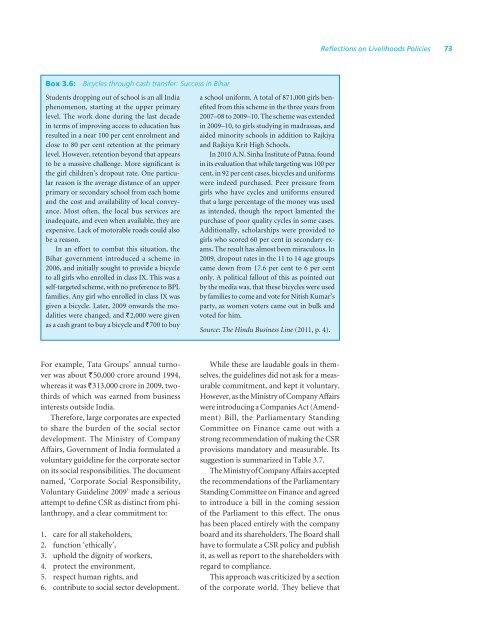SOIL Report 2011 - ACCESS Development Services
SOIL Report 2011 - ACCESS Development Services
SOIL Report 2011 - ACCESS Development Services
- No tags were found...
Create successful ePaper yourself
Turn your PDF publications into a flip-book with our unique Google optimized e-Paper software.
Reflections on Livelihoods Policies 73Box 3.6: Bicycles through cash transfer: Success in BiharStudents dropping out of school is an all Indiaphenomenon, starting at the upper primarylevel. The work done during the last decadein terms of improving access to education hasresulted in a near 100 per cent enrolment andclose to 80 per cent retention at the primarylevel. However, retention beyond that appearsto be a massive challenge. More significant isthe girl children’s dropout rate. One particularreason is the average distance of an upperprimary or secondary school from each homeand the cost and availability of local conveyance.Most often, the local bus services areinadequate, and even when available, they areexpensive. Lack of motorable roads could alsobe a reason.In an effort to combat this situation, theBihar government introduced a scheme in2006, and initially sought to provide a bicycleto all girls who enrolled in class IX. This was aself-targeted scheme, with no preference to BPLfamilies. Any girl who enrolled in class IX wasgiven a bicycle. Later, 2009 onwards the modalitieswere changed, and `2,000 were givenas a cash grant to buy a bicycle and `700 to buya school uniform. A total of 871,000 girls benefitedfrom this scheme in the three years from2007–08 to 2009–10. The scheme was extendedin 2009–10, to girls studying in madrassas, andaided minority schools in addition to Rajkiyaand Rajkiya Krit High Schools.In 2010 A.N. Sinha Institute of Patna, foundin its evaluation that while targeting was 100 percent, in 92 per cent cases, bicycles and uniformswere indeed purchased. Peer pressure fromgirls who have cycles and uniforms ensuredthat a large percentage of the money was usedas intended, though the report lamented thepurchase of poor quality cycles in some cases.Additionally, scholarships were provided togirls who scored 60 per cent in secondary exams.The result has almost been miraculous. In2009, dropout rates in the 11 to 14 age groupscame down from 17.6 per cent to 6 per centonly. A political fallout of this as pointed outby the media was, that these bicycles were usedby families to come and vote for Nitish Kumar’sparty, as women voters came out in bulk andvoted for him.Source: The Hindu Business Line (<strong>2011</strong>, p. 4).For example, Tata Groups’ annual turnoverwas about `50,000 crore around 1994,whereas it was `313,000 crore in 2009, twothirdsof which was earned from businessinterests outside India.Therefore, large corporates are expectedto share the burden of the social sectordevelopment. The Ministry of CompanyAffairs, Government of India formulated avoluntary guideline for the corporate sectoron its social responsibilities. The documentnamed, ‘Corporate Social Responsibility,Voluntary Guideline 2009’ made a seriousattempt to define CSR as distinct from philanthropy,and a clear commitment to:1. care for all stakeholders,2. function ‘ethically’,3. uphold the dignity of workers,4. protect the environment,5. respect human rights, and6. contribute to social sector development.While these are laudable goals in themselves,the guidelines did not ask for a measurablecommitment, and kept it voluntary.However, as the Ministry of Company Affairswere introducing a Companies Act (Amendment)Bill, the Parliamentary StandingCommittee on Finance came out with astrong recommendation of making the CSRprovisions mandatory and measurable. Itssuggestion is summarized in Table 3.7.The Ministry of Company Affairs acceptedthe recommendations of the ParliamentaryStanding Committee on Finance and agreedto introduce a bill in the coming sessionof the Parliament to this effect. The onushas been placed entirely with the companyboard and its shareholders. The Board shallhave to formulate a CSR policy and publishit, as well as report to the shareholders withregard to compliance.This approach was criticized by a sectionof the corporate world. They believe that














